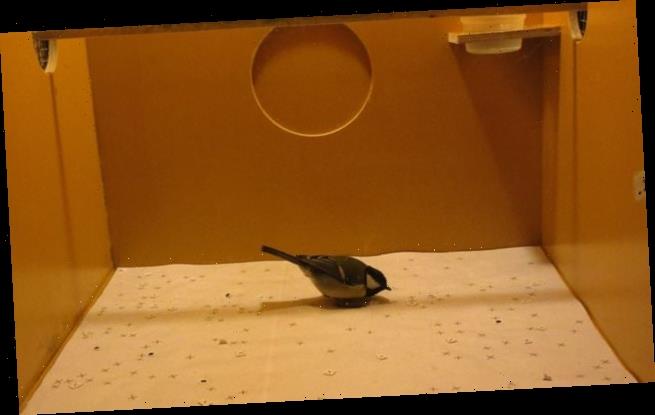Blue tits learn to avoid foul-tasting food by watching footage of other birds reacting badly to distasteful and toxic bugs
- The small garden birds learn to avoid poisonous and distasteful creatures
- A blue tit will steer clear of the food if another bird that ate it looks disgusted
- The birds learned from each other and not just their own species
Birds learn to avoid potentially toxic and distasteful food by watching the behaviour of other birds, a study has found.
UK-based researchers played blue tits and great tits videos of other birds eating unpalatable food to represent foul-tasting insects in the wild.
Seeing the ‘disgust response’ from other birds on TV screens helped them avoid unpleasant-tasting food, such as bitter almonds marked in distinctive packaging.
Blue tits learned best by watching their own species, while great tits learned just as well from blue tits and other grey tits.
UK-based researchers played blue tits and great tits videos of other birds eating unpalatable food to represent foul-tasting insects in the wild and watched their response
In the wild, this skill can potentially increase the survival rate of not only birds but their insect prey.
Predators such as birds have to work out whether their potential prey is worth eating or likely to be poisonous – and watching fellow birds can help them decide.
‘Blue tits and great tits forage together and have a similar diet, but they may differ in their hesitation to try novel food,’ said lead study author Liisa Hämäläinen of the University of Cambridge.
‘By watching others, they can learn quickly and safely which prey are best to eat.
‘This can reduce the time and energy they invest in trying different prey, and also help them avoid the ill effects of eating toxic prey.’
The study involved 48 blue tits and 39 great tits from the wild, each placed inside a wooden box with a perch opposite a TV screen.
On the floor of this box were two sets of tiny white packets containing either delicious or disgusting morsels – each marked with a different symbol.
The tasty almonds were placed in white packets with small black cross symbol, while the disgusting almonds – which had been soaked in a bitter solution – were marked with a black square.
Once inside the box, each of their birds were shown a video of another bird’s response as it ate a distasteful item of food.
Pictured: a bird watches another bird on television eat disgusting food. The negative reaction will inform its behaviour in the wild.The bird on the screen showed its disgust through vigorous beak wiping and head shaking
Birds that had watched TV clips had were likely to avoid food that they had learned tasted bad, the researchers found. Blue tits learned best by watching their own species, while great tits learned just as well from blue tits and other grey tits
The bird on the screen showed its disgust through vigorous beak wiping and head shaking.
Birds that had watched TV clips had were likely to avoid food that they had learned tasted bad, the researchers found.
Blue tits as a whole ate 11 fewer packets of bitter food when they saw it being rejected by another blue tit on TV – and seven fewer when they watched a ‘disgusted’ great tit.
As for great tits, they ate five fewer packets of foul almonds when they saw another either a blue tit or great tit shake their head.
Previously, scientists had thought great tits were more adept at learning through observing others than blue tits.
This study, published in the Journal of Animal Ecology, is the first to show that blue tits are just as good as great tits in this regard.
Blue tits and great tits are part of the same family of birds and tend to forage together.
Insect species such as ladybirds, firebugs and tiger months have conspicuous or colourful markings and bitter-tasting chemical defences to deter predators.
‘Conspicuous warning colours are an effective anti-predator defence for insects, but only after predators have learnt to associate the warning signal with a disgusting taste,’ said Hämäläinen, who is now at Macquarie University in Australia.
If prey avoidance behaviour spreads quickly throughout both species, this could benefit ongoing survival of both.
Luckily for the insects, the birds’ intuitive learning skills also help prevent them from being chewed up and spat out, improving their survival rates too.
Source: Read Full Article



